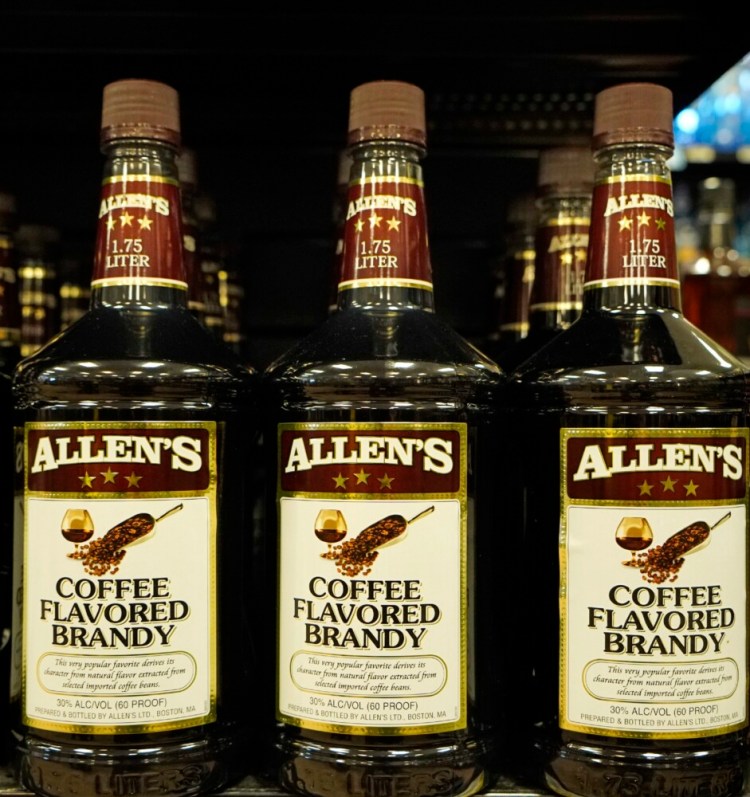Mainers now spend more on Fireball Cinnamon Whisky and Tito’s Handmade Vodka than on the state’s longtime favorite spirit, Allen’s Coffee Flavored Brandy.

Sales revenue for Fireball and Tito’s has surged over the past six years, while Allen’s market share has slowly declined, according to state alcoholic beverage records obtained by the Portland Press Herald. Last year, Mainers spent $12.2 million on Fireball and $11.7 million on Tito’s, the records show.
Allen’s, which had been the top-selling liquor in Maine for decades, slipped to third place last year, accounting for $9.2 million in sales.
But those figures don’t reflect the total volume of Allen’s sold in Maine. Based on sales of 9-liter cases – a standard unit of measurement for the spirits industry – Allen’s still is Maine’s most purchased hard alcohol, said Gary Shaw, executive vice president at M.S. Walker, the Norwood, Massachusetts, company that produces the brandy.
“Everything being equal, Allen’s continues to hold the No. 1 spot in the state of Maine,” Shaw said. “We always looked at equalized volume as our benchmark. We have been in top position in Maine for a lot of years.”
Allen’s sold 90,859 cases in Maine in 2019, about 27 percent more than Tito’s, the next-biggest seller at 71,471 cases. Fireball, which is bottled in Lewiston for regional distribution, sold 66,211 cases.
Fireball is popular, but much of its 2019 sales revenue came from small, 50-milliliter and 100-milliliter bottles, called “nips,” which are more profitable, Shaw said. Allen’s is sold only in larger bottles.
But it’s hard to deny that Allen’s is losing some of its appeal in Maine. Sales revenue has dropped by 16 percent since 2014, and the brand sold almost 3,740 fewer 9-liter cases in 2019 than it did the year before. Maine is the only major market for the brandy.
“The consumers of Maine are opened up to (buying) more brands that are more national in scope,” Shaw said. “That trend continues, (but) we certainly continue to be very proud that by sheer volume, (Allen’s) is No. 1 in the state and we are very active in the marketplace.”
Mainers generally drink more alcohol than people in other states, with Maine ranking 12th in the country, including the District of Columbia, for per-capita alcohol consumption, according to 2017 research from the National Institute on Alcohol Abuse and Alcoholism. The ranking is based on sales data, so it includes purchases in Maine by visitors from other states, including tourists.
Fireball’s maker, Sazerac Co. of New Orleans, is “pleased with Fireball’s success in Maine and other states,” public relations manager Amy Preske said in an email.

The growth of Tito’s and Fireball helped increase the bottom line of the state’s liquor business in 2019. Maine is one of 17 states with a monopoly on the sale of distilled spirits.
Maine reported a net income of $56.3 million on the sale of spirits in the 2018-19 fiscal year, the biggest profit since state government reformed its liquor system six years ago. Almost $200 million in spirits were sold in the state during the most recent fiscal year.
Under a 10-year warehousing, distribution and marketing contract with Pine State Trading Co., Maine’s liquor sales revenue has grown by 5 percent annually on average, said Gregg Mineo, director of the Bureau of Alcoholic Beverages and Lottery Operations.
“That is very, very healthy,” he said. “I don’t know of anyone early on who expected the growth rate to be what it is.”
A strong economy, diverse product line and competitive pricing have helped boost the state’s liquor sales, but the growth of Fireball and Tito’s is especially notable, Mineo said.
The two brands, combined with Allen’s, accounted for 17 percent of total liquor sales last year, according to an analysis of state records.
Repricing some products helped boost the state’s revenue, too. In 2017, the state’s liquor commission raised prices on almost 800 products, including nips, which increased from 99 cents to $1.49.
Maine’s roughly $200 million in alcohol sales revenue for the most recent fiscal year exceeded projections by nearly 25 percent. Net income, used to pay down a 10-year bond issued in 2014 to repay the state’s hospital debt, has exceeded estimates by an average of 25 percent each year.
“Our business is all good news – we are so proud of this business model,” Mineo said. “This model, as far as I am concerned, is not going anywhere and it should not go anywhere.”
Send questions/comments to the editors.




Comments are no longer available on this story